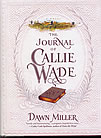
"There are memories in our lives that never fadegiven to us as gifts....
The memory of my greatgrandmother was one of
my gifts, and the true inspiration for this story...." -Dawn
Miller Dawn Miller's marvelous debut novel is a grand adventure-and a glorious love story-experienced with all the passion and yearning of a character you'll never forget: eighteen-year-old Callie Wade, whose hopeful heart is as rich with promise as the beckoning frontier.... When the wagon train finally pulled away, the men shot off their guns and hollered their cheers for the new territory and I saw Jack wave them on, his eyes dancing with the prospect of riches and Indian fighting. For the men, these journeys seem to hold such adventure. ... But what of the women?... -The Journal of Callie Wade Independence, Missouri, May 3, 1859: "Home is where your heart leads you...... Mama had better be right, because we are traveling with a bunch of quite peculiar strangers. My dear little sister Rose may have lungs as frail as cobwebs, but I pray she'll live to see the California sun. Pa and my wild-hearted brother, Jack, are raring to go, but it's the women who have the salt to beat all. Walking miles in the dust, birthing babies on the trail... they'd put a general to shame. But I'm scared, and acting snappish-enough to put off Quinn McGregor you might suppose. He's got a blacksmith's strength and the soul of a poet, and his grave blue Irish eyes seem to keep finding mine... When things get rough, remember: "It's the rubbin that brings out the shine, " said Mama, and I'm sure shining, through Kansas dust and Colorado rain and the parching Utah sun. Maybe it's true that life ain't in holdin a good hand, but playin a poor one well! But oh how I cherish the dances under the stars, the coffee brewed over sage fires, the beautiful pair of beaded moccasins left me as a secret gift... and the great love growing in my heart for Quinn...
The Journal of Callie Wade invites us into a world long vanished, brought to life once more in the once-in- a -lifetime experiences of a young pioneer woman. Here is her story, rich in love and sorrow, grit and grandeur...inspiring and unforgettable. Review by Sandy Huseby
|